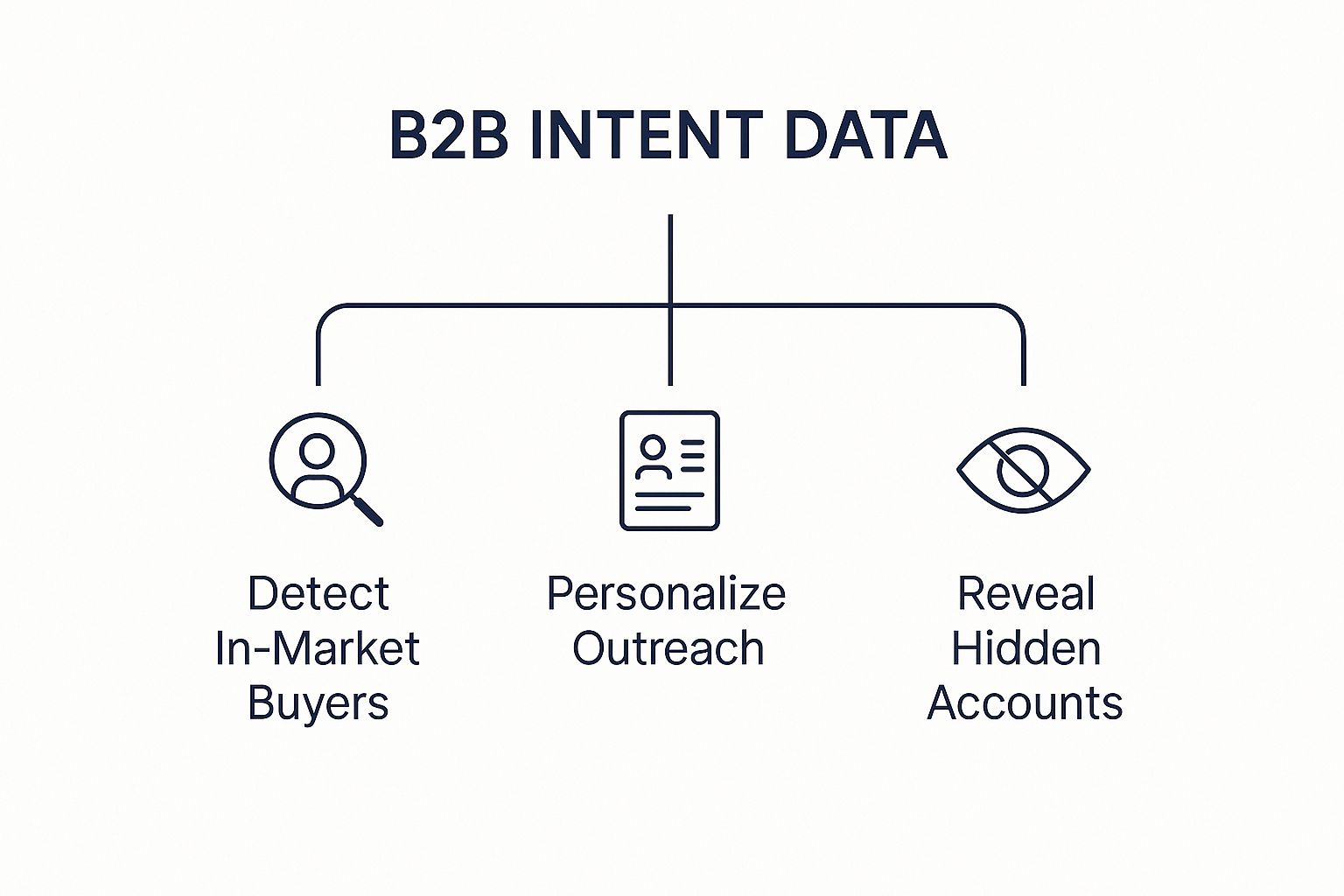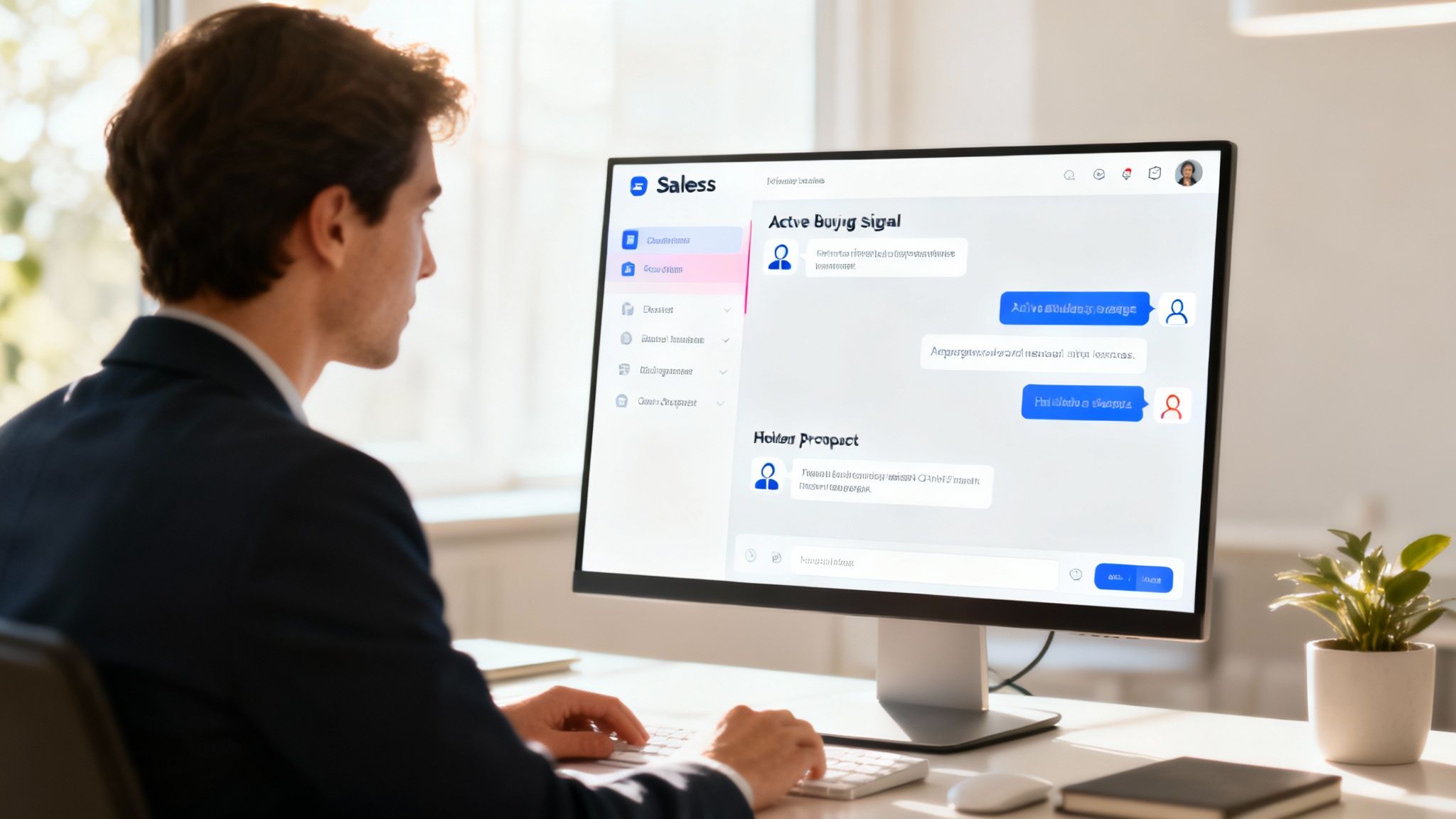A Guide to B2B Sales Champion Tracking
Unlock deals faster with our guide to champion tracking. Learn how to identify, enable, and track internal champions to close more B2A B sales.
Unlock the power of B2B intent data. Learn how it works, why it matters, and how to use it to identify buyers and close deals before your competitors do.
What exactly is B2B intent data? Think of it as the digital breadcrumbs a company leaves online. These clues reveal what they're researching, signaling interest in certain products or services long before they ever contact a salesperson.
In short, it’s how you know which accounts are actively looking for a solution like yours right now. This gives your sales and marketing teams a massive head start, letting you focus on buyers who are already in-market instead of just guessing.
Let's be honest, traditional B2B sales is getting tougher. Buyers complete most of their research online, often before a sales rep even knows they exist. This isn't a small shift; it changes how sales and marketing teams need to operate. You can't afford to just wait for prospects to raise their hands. You have to meet them where they are.
This is where intent data becomes your secret weapon. It helps you uncover clues about a prospect's buying journey as it happens. Instead of blasting out cold calls to a massive, generic list, you can laser-focus on accounts already showing they’re ready to talk.
Without intent data, sales teams are stuck using static criteria like company size, industry, or location. While these data points are a decent start, they don't tell you the most important thing: timing. A company might look perfect on paper, but if they aren't looking to buy now, your outreach will fall flat.
B2B intent data bridges that gap.
B2B intent data helps you answer the "why now?" question. It shifts your strategy from a reactive, inbound-dependent model to a proactive, insight-driven approach that anticipates what buyers need.
This insight is quickly becoming non-negotiable. The B2B intent data market is on track to hit $1.5 billion by 2025, and for good reason. By the time a potential buyer reaches out, they are often 60-90% of the way through their decision-making process. You can learn more about these trends in our guide to signal-based selling.
This infographic breaks down the core advantages of using B2B intent data.

Its real power lies in detecting active buyers, enabling personalized outreach, and even uncovering opportunities you never knew existed. For any modern revenue team, it’s a foundational tool.
So, where does this valuable information come from? It’s not as mysterious as it sounds. B2B intent data is about piecing together the digital breadcrumbs your ideal customers leave behind every day.
Your best-fit accounts are constantly "talking" about their business problems and the solutions they’re exploring. Some of these conversations happen on your website. Others happen with your partners. And a huge number of them take place all across the web.
The goal of intent data is to listen in on all of these conversations. To do that, you need to understand the three core data types. Each gives you a different piece of the puzzle, and together, they create a clear picture of who is ready to buy.
First-party data is the information you collect yourself, straight from your audience. This is the gold standard of intent data because it’s yours alone—it comes with consent and you know exactly what it means. It’s the digital equivalent of a prospect walking into your store and telling you what they’re looking for.
These are buying signals generated on your own digital properties.
This data is incredibly powerful. You have full control and context, making it the foundation of any intent-driven strategy.
Second-party data is simply someone else's first-party data that they share or sell to you. Think of it like a trusted partner in your industry referring a potential customer. For example, a non-competing tech company might share anonymized data showing that their audience is researching a problem your product solves.
This data is a great way to find audiences you might not otherwise reach. It’s already qualified because it comes from a source that serves a similar customer profile.
While powerful, both first and second-party data only show you a slice of the pie. They capture interactions with your brand or a partner's, but they miss the vast majority of research happening elsewhere.
This is where the third data type comes in, giving you a much broader view of the market.
Third-party data is information aggregated from countless external sources across the internet. This gives you a wide-angle lens, showing you what your target accounts are researching when they aren't on your website. It’s how you uncover "invisible" buyers who are deep in research but haven’t engaged with you yet.
This information is typically gathered from a massive network of B2B websites, publications, and online communities.
Each data type reveals a different part of the buyer's journey. To help you connect the dots, here’s a quick breakdown of where these signals come from and what they mean.
| Data Type | Primary Source | Example Signals |
|---|---|---|
| First-Party | Your own digital properties (website, CRM, marketing automation) | Visiting pricing pages, downloading ebooks, high email engagement, repeat visits from target accounts. |
| Second-Party | Direct partnerships with non-competing companies or industry sites | Anonymized audience data showing interest in relevant topics, webinar co-registrations. |
| Third-Party | B2B publisher networks, review sites, public forums | Spikes in research on specific keywords, vendor comparisons on G2/Capterra, forum discussions. |
By combining all three data types, you move from guesswork to a data-backed approach for engaging in-market accounts. You can learn more about translating these interactions into action by exploring different buying signals in sales. It's the key to making sure your team is always talking to the right people at the right time.

Knowing the theory behind B2B intent data is one thing; using it to drive revenue is another. For sales teams, this isn't just another metric. It’s a tool that changes how they prioritize, engage, and close deals.
The big shift? Moving from "who could we sell to?" to "who is ready to buy now?"
The impact is immediate. Once you pipe intent data into your daily sales workflow, you give reps the context they need to be more relevant in every conversation. Let's dig into three ways your sales team can use these insights to get a leg up on the competition.
A sales rep's most valuable asset is time. Without clear signals, they waste hours chasing accounts that look good on paper but have no immediate need. Intent data flips that dynamic, acting as a powerful filter for what matters.
Instead of working through a static list, reps can focus on companies that are actively researching solutions like yours. A modern sales intelligence platform surfaces these signals in real-time, letting your team know the second an account heats up. Reps can start their day knowing exactly where the action is.
This proactive approach helps teams:
Generic, one-size-fits-all outreach is dead. Today’s B2B buyers expect you to know something about their business before you contact them. This is where intent data shines, giving you the specific context needed for personalization that works.
Imagine your rep sees that a target account is suddenly researching one of your competitors. Instead of sending a bland "checking in" email, they can craft a message that hits the mark.
"Hi [Prospect], I noticed your team might be evaluating solutions for [pain point]. While you're comparing options like [Competitor Name], I wanted to share how we help companies like yours solve this differently by focusing on [Your Key Differentiator]."
That level of relevance is impossible without intent data. It lets you go beyond basic personalization (like using a name and company) and connect with prospects based on what they're doing right now. This simple shift builds instant credibility.
Some of your best future customers are out there right now, fitting your ideal customer profile (ICP) perfectly, but they've never visited your website or downloaded your content. As far as you're concerned, they're invisible. Traditional lead gen methods will miss them completely.
These accounts are deep in their buying journey, but their research is happening on third-party sites—review platforms, industry blogs, and forums.
Third-party intent data is the only way to bring these hidden accounts into view. It scans the web for signals, alerting you when an ICP account starts researching relevant keywords or engaging with content about the problems you solve.
This expands your total addressable market. You're no longer limited to the accounts you already know. Instead, you get a constant stream of new, in-market opportunities delivered to your sales team, letting them engage prospects who would have otherwise stayed off their radar.
The results speak for themselves. Companies using intent data report massive benefits, with a nearly 99% rate of increased sales or ROI. Even better, 17% of B2B pros have boosted lead conversion rates by 30% by building these signals into their process. You can explore more data on how intent drives revenue growth and see how powerful this can be.

While sales teams get an immediate boost from B2B intent data, its impact on marketing is just as powerful. For marketers, intent data brings fuzzy campaign goals into sharp focus. It shifts marketing from a broad "spray-and-pray" approach to a precise, revenue-driving machine.
Instead of burning your budget trying to educate an entire market, you can zero in on the accounts that are already in a buying cycle. This isn't just about efficiency—it changes how marketing contributes to the bottom line. Every dollar gets spent engaging companies with a real, immediate need.
One of the biggest holes in a marketing budget is wasted ad spend. Every dollar spent showing an ad to a company that isn't ready to buy is a dollar wasted. Intent data plugs that leak by helping you build ad audiences composed only of in-market accounts.
Imagine running a LinkedIn campaign. The old way was targeting based on broad firmographics like industry and company size. The new way? Create a dynamic audience of accounts that are currently researching your solution or your competitors. Your ads are only seen by decision-makers at companies actively weighing their options.
This approach gives your key advertising metrics a serious lift:
To understand why this works, it helps to know the core behavioral targeting principles that power it. Tracking these digital actions is what turns generic campaigns into surgical strikes.
Content marketing is a long game, but intent data can shorten the time to impact. Your team might be producing fantastic content, but if it doesn't align with what your target accounts care about right now, it will fall flat.
Intent data gives you a direct line into the topics and pain points your ideal customers are actively researching.
By monitoring third-party intent signals, you can see which keywords and subjects are trending among your target accounts. This insight allows you to create content that directly answers their most pressing questions, positioning your brand as a helpful authority.
For example, if you see a surge in research around "data integration challenges," your content team can quickly create a guide or webinar on that exact topic. This data-informed approach ensures your content calendar is always relevant. You start attracting high-fit accounts at the moment they're looking for help. It’s the difference between shouting into the void and joining a conversation already in progress.
Account-based marketing is built on a simple idea: treat individual accounts as markets of one. Its success hinges on selecting the right accounts and engaging them with relevant messaging. B2B intent data is the fuel that makes a high-performance ABM engine run.
Without it, ABM can feel like a sophisticated guessing game. With it, every decision is backed by data.
Intent data supercharges your ABM strategy in a few ways:
Weaving intent data into your ABM program ensures your efforts are aimed at accounts that aren't just a good fit, but are also ready for a conversation. If you want to dive deeper, you can learn more about the essential account-based marketing metrics that prove the ROI of these focused campaigns.
Picking a B2B intent data provider is a decision that can have massive downstream effects. The right partner acts as a force multiplier for your entire go-to-market team. The wrong one sends you chasing ghosts with bad information, wasting everyone's time.
This isn’t about just picking the biggest name. It’s about finding a provider whose data quality, methodology, and ethical standards align with your goals.
Not all intent data is created equal. The differences can make or break your results. Outdated signals will have your sales team chasing accounts that are no longer in-market. Data that lacks accuracy or context is just noise. Your goal is to find a provider who delivers clear, actionable intelligence—not just a mountain of raw data.
The foundation of any good intent data solution is the quality of its information. This is non-negotiable. Before you sign a contract, you need to dig into how a provider sources, verifies, and updates its data. Stale data isn't just unhelpful—it's actively harmful, leading to irrelevant outreach and a damaged brand reputation.
Here are the core pillars to investigate:
The ultimate test of an intent data provider is whether their signals consistently lead to meaningful conversations. The goal is a partner that delivers a high signal-to-noise ratio, ensuring your team spends its time on genuine opportunities.
In a world full of data regulations like GDPR and CCPA, how a provider handles privacy isn't just a feature—it's a critical business requirement. Partnering with a non-compliant provider exposes your company to serious legal and financial risks. You need a partner who has built their process around ethical data handling from day one.
This is where you need to ask tough questions.
The rise of B2B intent data has created a crowded market, but this growth is balanced by challenges around data privacy and accuracy. This is driving a demand for higher quality and more ethical practices.
Choosing a provider with a strong, transparent stance on privacy protects your business and builds trust with future customers. To help you sort through the options, a list of the best intent data providers can be an excellent starting point for your research.

The world of B2B intent data is changing fast. For a long time, it was about knowing what a company was researching. Thanks to AI, we're making a huge leap forward. Now, we can understand who inside that company is on the buying committee and, more importantly, why their research matters right now.
This is the difference between raw data and true intelligence. AI-driven platforms are no longer just flagging a company for searching a few keywords. They're now sifting through countless signals to predict the best next move for your sales team. It’s a deeper level of analysis that can tell the difference between casual research and a team that's genuinely ready to buy.
Let's be clear: AI isn't here to replace great salespeople. It's better to think of it as a powerful co-pilot. It does the heavy lifting—analyzing data and connecting dots a human could miss. This frees up your reps to do what they do best: build relationships and close deals.
AI helps your team find answers to critical questions that basic intent data can't touch:
AI transforms intent data from a simple "hot account" alert into a proactive game plan. It doesn't just tell you an account is showing interest; it tells you why and gives you the angle you need to start a meaningful conversation.
This isn't just a niche trend; it's driving massive market growth. The global market for B2B Buyer Intent Data Tools was valued at around $1.2 billion in 2023 and is projected to hit $4.8 billion by 2032. This explosion is thanks to tech improvements that deliver smarter, more usable insights. You can dig into more details about this growing market on dataintelo.com.
The future of intent intelligence is about AI’s ability to turn billions of data points into a clear, strategic story. This gives revenue teams the power to act with more precision and confidence in every interaction.
Even with a solid plan, jumping into B2B intent data can feel like learning a new language. It’s natural for teams to have questions. Is it worth the investment? Is the data reliable enough to act on?
Let's cut through the noise and tackle some common concerns.
A big one is accuracy. How can you be sure you’re chasing real signals and not digital ghosts? Reputable providers don’t just scrape a single source; they aggregate and cross-reference signals from many high-quality places. This filters out random clicks and false positives, ensuring your team acts on credible buying behavior.
Another hurdle is integration. Sales leaders worry about adding another tool to their already crowded tech stack. The best intent platforms are built to slide right into your existing CRM and sales engagement tools. They push actionable insights directly into the workflows your reps already use, making adoption seamless.
This is where things get interesting, and it's a major point of confusion for many teams. Most providers tell you which company is showing interest, but that information is often too broad to be useful.
Knowing someone at a 10,000-person corporation is researching your type of solution doesn't give your sales rep much to go on. Who do they call? What do they say?
The real game-changer is contact-level intent. It cuts through the ambiguity, moving beyond the organization to pinpoint the specific individuals on the buying committee who are doing the research. This allows your team to personalize outreach directly to the right people.
This deeper level of insight is what separates the good from the great. While account-level signals are great for prioritizing your target list, contact-level data tells you exactly who to talk to and what their pain points are. It closes the gap between knowing an account is warm and starting a meaningful conversation.
Ultimately, B2B intent data is most powerful when it’s accurate, easy to integrate, and provides the granular, person-specific insights that lead directly to more pipeline.
Ready to transform raw signals into actionable intelligence? With Salesmotion, your team gets AI-powered insights delivered directly into their workflow, turning account activity into pipeline growth. Discover how Salesmotion can elevate your sales strategy.
Unlock deals faster with our guide to champion tracking. Learn how to identify, enable, and track internal champions to close more B2A B sales.
Learn what is intent data and how it helps you find B2B buyers who are ready to purchase. Unlock powerful strategies for your sales and marketing...
Get a clear target account selling definition. Learn how TAS drives revenue, its core components, and how to build a winning B2B sales strategy.